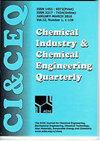湍流对颗粒团块阻力系数确定的数值研究
IF 0.8
4区 工程技术
Q4 CHEMISTRY, APPLIED
Chemical Industry & Chemical Engineering Quarterly
Pub Date : 2023-01-01
DOI:10.2298/ciceq221206021o
引用次数: 1
摘要
利用计算流体力学对颗粒团块周围的流动进行了数值模拟,以评估5种RANS湍流模型对颗粒团块阻力系数的估计能力。在雷诺数在1 ~ 1500之间的稳态条件下进行了模拟。流线显示,对称团块呈现出与单球体相似的速度剖面。结果表明,Spalart-Allmaras和SST k-?湍流模型不仅可以反映团块壁面附近和远处区域的流动情况,还可以反映团块尾部尾迹区域的流动情况。RNG k-?模型对速度分布和阻力系数的预测质量较差。模拟得到的阻力系数与trans - cong模型的趋势一致,且随团聚体堆积密度的增加,与预测值的偏差减小。结果表明,采用稳态RANS模拟是一种可行、有效、计算成本低的预测颗粒团块阻力系数的方法。对于过渡流和湍流,结果一致,偏差在-15%到13%之间,而对于较低雷诺数,偏差在-25%到5%之间。本文章由计算机程序翻译,如有差异,请以英文原文为准。
Numerical study of turbulence on drag coefficient determination for particle agglomerates
Numerical simulations of the flow surrounding particle agglomerates were carried out using computational fluid dynamics to assess the ability of five RANS turbulence models to estimate the drag coefficient in particle agglomerates. Simulations were carried out in steady conditions for Reynolds numbers between 1 and 1500. Streamlines showed that symmetrical agglomerates present a velocity profile similar to the single sphere profile. Results showed that both Spalart-Allmaras and SST k-? turbulence models can represent the flow profile not only in the regions near and far from the walls of the agglomerates but also the wake region in the rear of the agglomerates. The RNG k-? model showed poor quality to predict both the velocity profile and the drag coefficient. The drag coefficient obtained by simulations presented a trend better represented by the Tran-Cong model, also showing that deviations from the predictions decreased as the packing density of the agglomerate increased. The use of steady RANS simulations showed to be a feasible and efficient method to predict, with low computational cost, the drag coefficient in particle agglomerates. For the transition and turbulent flows, results presented good agreement, with deviations between -15% and 13%, while for lower Reynolds numbers, deviations varied between -25% and 5%.
求助全文
通过发布文献求助,成功后即可免费获取论文全文。
去求助
来源期刊

Chemical Industry & Chemical Engineering Quarterly
CHEMISTRY, APPLIED-ENGINEERING, CHEMICAL
CiteScore
2.10
自引率
0.00%
发文量
24
审稿时长
3.3 months
期刊介绍:
The Journal invites contributions to the following two main areas:
• Applied Chemistry dealing with the application of basic chemical sciences to industry
• Chemical Engineering dealing with the chemical and biochemical conversion of raw materials into different products as well as the design and operation of plants and equipment.
The Journal welcomes contributions focused on:
Chemical and Biochemical Engineering [...]
Process Systems Engineering[...]
Environmental Chemical and Process Engineering[...]
Materials Synthesis and Processing[...]
Food and Bioproducts Processing[...]
Process Technology[...]
 求助内容:
求助内容: 应助结果提醒方式:
应助结果提醒方式:


